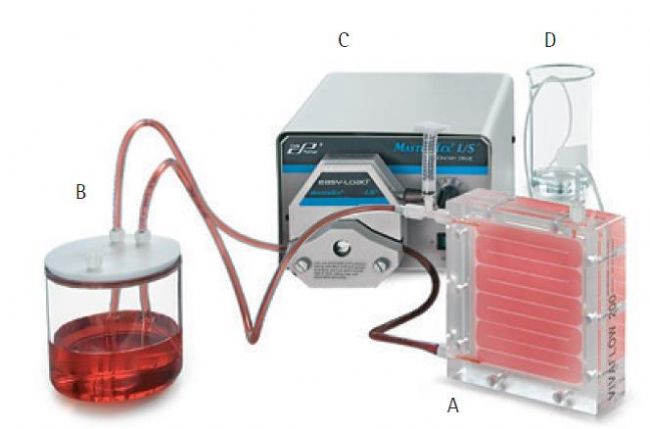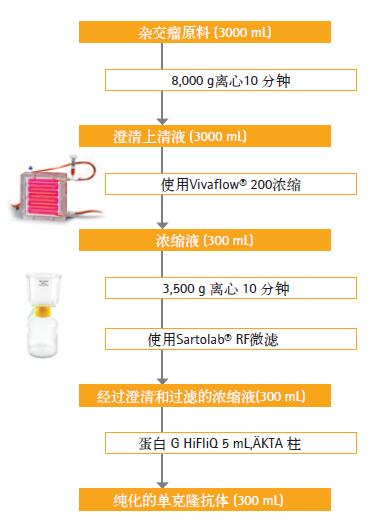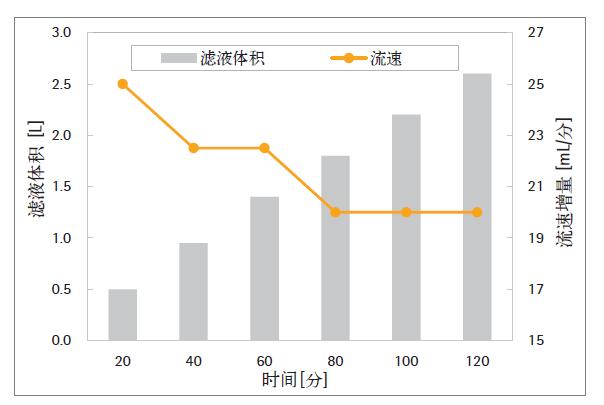Key sample preparation tool for hybridoma supernatant concentration
Summary
The focus of this study was to condense up to 3 L of mouse hybridoma clarified supernatants by 10 fold prior to affinity chromatography using a Vivaflow ® 200 tangential flow envelope. The study found that when using two Vivaflow ® 200 (molecular weight cut off (MWCO) 30 kDa), the antibody recovery rate was always over 98% and the concentration rate was about 20 – 25 mL/min.
Introduction
Monoclonal antibodies produced using hybridoma technology are widely used in the production of (bio) pharmaceutical industries, research, and in vitro diagnostic (IVD) products. Analytical techniques such as Western blotting, immunofluorescence, and ELISA are widely used. The production and processing of monoclonal antibodies – especially for IVD market users – requires quality assurance measures such as the implementation of the ISO 9001 quality system and the adoption of zui's new technology.
An indispensable step in antibody production is the use of ultrafiltration and microfiltration membranes for filtration (1, 2). Stirring and pressure filtration was once the most common laboratory concentration method with a concentration of less than 500 mL. Common FAQs in the past include slow speed, excessive foaming, and a lack of dead volume retention resulting in a large loss of antibodies. This forces production scientists to look for a laboratory-scale tangent flow filtration (TFF) method.
TFF is widely used for clarification, concentration or buffer exchange of proteins and antibodies using microfiltration or ultrafiltration membranes (3, 4). Raw material lateral flow filtration membrane (tangent). In ultrafiltration mode, low molecular weight molecules are filtered through the membrane to the filtrate, while the material containing the antibody of interest is continuously concentrated to a relatively high protein concentration in a short period of time.

Figure 1: Vivaflow ® 200 tangential flow membrane pack (A) and sample container (B), peristaltic pump (C) and filtrate collection vial (D).
Stable, reliable, and repeatable sample preparation (such as protein and antibody concentration/buffer exchange) is a fundamental step in the downstream processing of all biological reagents. At BioservUK, the Vivaflow ® 200 Circulating Channel Membrane Pack has been the sho selection tool for protein A or protein G preparation of pre-chromatographic hybridoma clarified supernatant material concentrates up to 3 L. The following parameters should be considered when selecting an ultrafiltration concentrator: quality of the ultrafiltration membrane, concentration rate, antibody recovery, reusability, and cost effectiveness.
In this article, we describe the use of the tangential flow process in BioservUK to concentrate different mouse IgG monoclonal antibody subclasses.
Materials and Method

Figure 2: Workflow for downstream processing of 3 L hybridoma material at BioservUK.
The supernatant was obtained from hybridoma cells which were fused with murine B lymphocytes and Sp2.0 mouse myeloma cell lines and subjected to spinner flask culture. Hybridoma cells were routinely cultured in RPMI 1640 medium (Gibco Cat. No. 21875) supplemented with EU-approved 10% fetal bovine serum (Gibco article number). One of the raw materials was centrifuged at 8,000 g for 10 minutes at 4 to 8 ° C to carry out clarification. The VF200 was pre-cleaned with 2 L of water to remove the storage buffer. Check the integrity of Vivaflow ® 200 during the pre-cleaning process for more than 1 minute to ensure a filtrate flow rate > 55 mL/min.
The supernatant was then concentrated 10 times with two parallel connected Vivaflow ® 200 (30 kDa MWCO, PES, Sartorius Cat. No. VF20P2) and No. 15 pump head (Figure 1). The antibody concentration in the cell culture fluid is usually about 30 mg/L. The antibody concentration after treatment with Vivaflow ® 200 is typically about 300 mg/L (10 times concentrated).
The maximum flow rate of the Vivaflow ® 200 concentrator is indicated by 3 atmospheric pressure limits. After concentration of the antibody, the membrane pack was washed with 2 L of water and then in situ (CiP) for 40 minutes in a recirculation mode with 500 ml of 0.5 M NaOH and 1% sodium hypochlorite solution. The membrane pack was then rinsed with 2 L of water and finally 200 ml of 20% ethanol was added and stored at 2-8 °C. The 300 mL concentrate was centrifuged at 3,500 g for 10 minutes to further remove particulate matter, and then filtered with a 500 ml Sartolab RF vacuum filter (Sartorius Cat. No. 180C2-E) for 0.22 μm, followed by protein G HiFliQ 5 mL column purification (protein Ark). Item No.: HiFlIQ5-PG-5).
result
Vivaflow ® 200 is included in our Standard Operating Procedures (SOPs) for all 1–3 L sample concentration steps. The instrument is extremely easy to use and has an antibody recovery rate of > 98% at a concentration rate of approximately 20 – 25 mL/min. It is important that the non-recyclable hold-up volume is less than 1 ml, which is ideal even if the pressure indicator lights up during the wash step. The complete stand-alone system can be easily connected and disconnected from the Masterflex Easy-Load peristaltic pump head and can be stored in the refrigerator for re-use at any time without manual adjustment. The system requires no manual operation and is clean and refreshing.
We monitor the flow rate every 20 minutes by measuring the filtrate volume at a constant speed of the peristaltic pump. The corresponding Masterflex L/S Economy Drive peristaltic pump is set to 3. Figure 4 shows the typical flow rate in the range of 20–25 mL/min. It takes about 2 hours to concentrate a 3 L sample by 10 times.
At BioservUK, we have established the Vivaflow ® system for different immunoglobulin G (IgG) subclasses. The recovery of all murine IgG subclasses (IgG1, IgG2a, IgG2b, IgG3) exceeded 98%. An in-situ cleaning was performed every 3 L of sample preparation. Each Vivaflow ® 200 membrane package is for a specific IgG subclass. Our SOP allows a maximum throughput of 50 L per membrane pack.

Figure 3: Example of flow rate measured at different times as a function of filter volume
in conclusion
The Vivaflow ® 200 Tangent Flow Membrane Pack is easy to use, fast, low cost, high throughput, and has a wide range of chemical compatibility and overall durability. Therefore, we performed 1–3 L hybridoma culture around this filtration concentration step. Downstream processing of the liquid. In the agitated pressure filtration device, the horizontal film disk used causes the immunoglobulin G to agglomerate on the surface of the membrane, resulting in a significant decrease in flow rate and an IgG loss of up to 40%.
We conclude that Vivaflow ® 200 is a unique laboratory-scale TFF consumable that has been shown to be an indispensable tool for the concentration of monoclonal IgG in a variety of subclasses. For samples up to 3 L in volume, Vivaflow ® 200 is still our shou option, a monoclonal antibody grade ultrafiltration concentrator.
references
1. Kemken R et al (1997) Dynamic membrane filtration in
Mammalian cell culture harvest. In: Carrondo MJT, Griffiths B,
Moreira JLP (eds) Animal Cell Technology. Springer, Dordrecht.
2. Bertera R, Steven H, Metcalfe M (1984) Development Studies
Of crossflow filtration, The Chemical Engineer. 401: 10.
3. Velez D, Miller L, MacMillan JD (1989) Use of tangential
Flow filtration in perfusion propagation of hybridoma cells
For production of monoclonal antibodies. Biotech & Bioeng,
33 (7): 938.
4. Van Reis R et al (1997) high performance tangential flow
Filtration. Biotech & Bioeng, 56 (1): 71.
Disclaimer
The experiments and methods have been completed independently, and the author is responsible for the entire content of this article.
Time Attendance,Time Attendance Software,Face Recognition Attendance,Card Recognition Time Attendance
Shenzhen Bio Technology Co., Ltd , https://www.hfsecuritytech.com